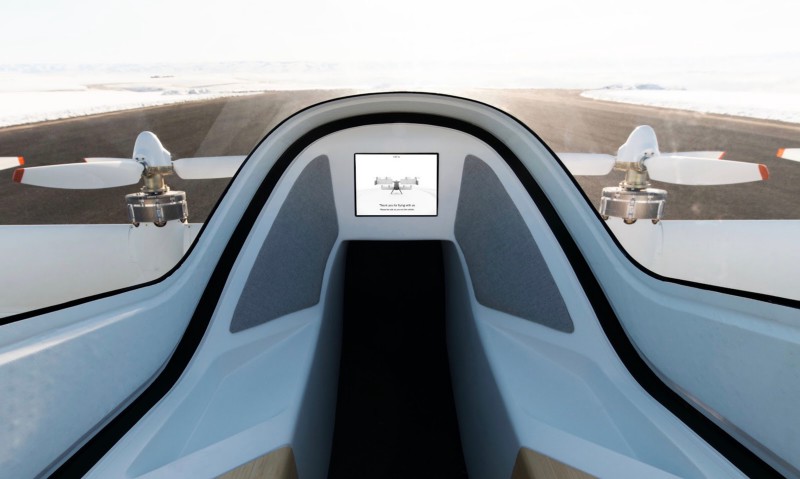
The single screen interior of the Alpha Two, the second full-scale Vahana demonstrator aircraft. Photo: Vahana/Airbus
Airbus A³ provided a glimpse of what the interior of a future self-piloted electric air taxi cockpit could look like, showing for the first time publicly the single-screen, pilotless forward-facing interior view of Alpha Two, its second full-scale Vahana demonstrator aircraft.
Inside the cockpit of the Vahana, there is enough space for one passenger, with a view featuring a single high definition screen showing the flight path of the passenger out ahead of the aircraft. There is no pilot seat, as the Vahana is remotely controlled in a configuration that the Silicon Valley division of Airbus is flight testing in Pendleton, Oregon.
Zach Lovering, vice president of urban air mobility at Airbus A³, told Avionics International that the only capability the remote pilot of the Vahana currently has is to start a flight, return the aircraft to its home base or land in place. The Vahana has reached 60 full-scale flight tests, including a transition from vertical to forward flight.
“The systems onboard Vahana Alpha that enable automated flight include GPS, inertial measurement units, air data probes, and several other sensors to gain information about the vehicle’s position and attitude. The general flight paths that the vehicle takes are pre-planned and flights are initiated by a remote operator,” said Lovering.
A combination of radar, camera and LIDAR units enable the Vahana to respond to in-air and on-the-ground hazards. Vahana can take off and land vertically using eight fans, and is designed to be able to trim at any speed during transition, even with the failure of any one of its eight motors.

An up close view of the nose cone of the Vahana shows one of the sensors it uses for its sense and avoid system. Photo: Vahana/Airbus
Throughout the development and flight-testing campaign of the Vahana, Airbus A³ has shared various details about the electric air taxi demonstrator’s aerodynamic features and what type of autonomous decision-making abilities it will need. As an example, a Vahana blog posted by Arne Stoschek, project executive for Wayfinder, in December 2017, stated that the aircraft’s navigation system needs to be capable of three dimensional problem solving at cruising speeds.
Separately Geoffrey Bower, chief engineer for Airbus A³ published a white paper showing how a team of aerodynamics engineers are using computational fluid dynamic simulations to develop the flight control system. Some of the factors being considered by the engineers includes how to design a digitally controlled trim maneuver for the interactions between multiple fans, wings and fuselage that occur when the aircraft is transitioning from vertical lift, to hover, to forward flight.
Vahana is one of several electric or hybrid electric air taxi programs in development at the moment, other programs such as Bell’s Nexus have established avionics partnerships with Garmin and Thales. Honeywell Aerospace also formed a partnership as the avionics maker for Pipistrel’s future electric air taxi development program. Even embedded systems companies such as Mercury Systems are already working on embedded processing architectures for future electric air taxi avionics.

The canopy of the Vahana opens up to welcome a passenger. Photo: Vahana/Airbus
Lovering said one of the tests being used on the Vahana to evaluate its navigation capabilities come in the form of “impulse inputs.”
“An impulse input is a short roll, pitch, yaw, or thrust command. For example, all within a few seconds, we temporarily increase the thrust command before returning it back to the nominally required thrust. These tests are important for us to understand how the vehicle responds to those inputs at each phase of flight. By observing and analyzing these responses we are able to guide further flight controls development,” said Lovering.
One of the main flight control aspects of the Vahana demonstrator flight testing program is to evaluate an air taxi’s ability to transition from vertical lift, to hover, to forward flight with the wings pointed forward. The transitions occur at speeds of up to 80-90 knots, Lovering said.

Want more eVTOL and air taxi news? Sign up for our brand new e-letter, “The Skyport,” where every other week you’ll find the most important analysis and insider scoops from the urban air mobility world.
Correction: This article has been updated to reflect an earlier statement about impulse inputs. According to Airbus, impulse inputs are a flight testing mechanism and have nothing to do with the Vahana’s flight control system.